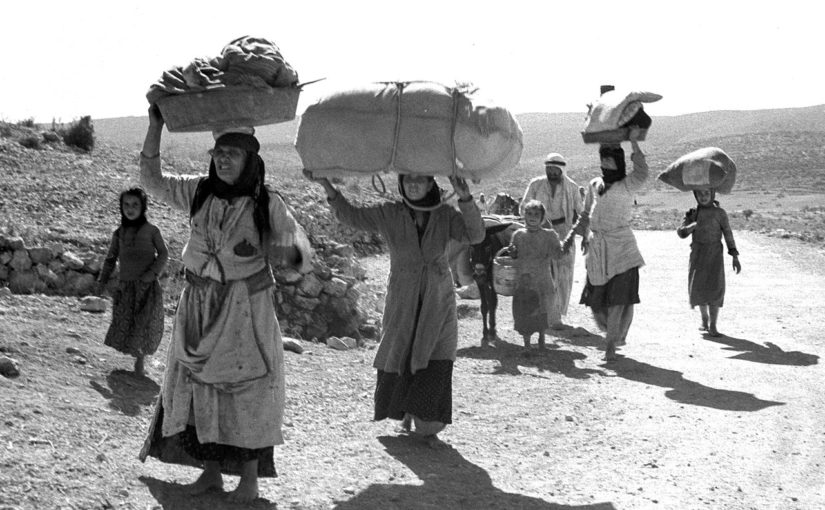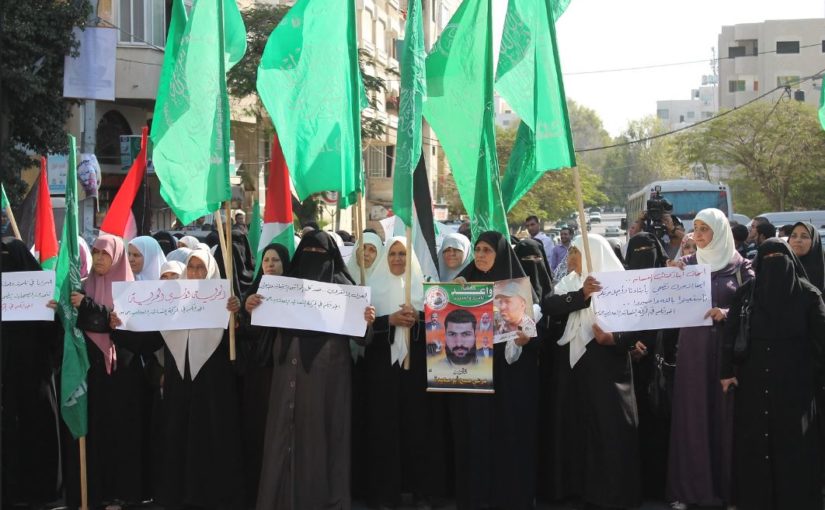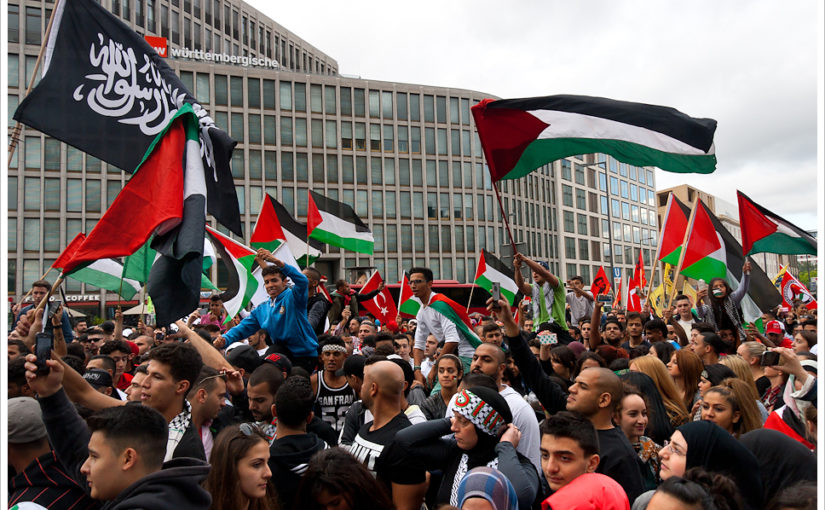One of the greatest problems in discussing the conflict between Israel and the Palestinians is the fact that the vast majority of people speaking about the issue have no understanding of either the history or the current reality. This is especially true of those who claim to support the Palestinians, and who in reality support Hamas or the PLO, the Palestinians’ actual oppressors. The facts of the current reality simply do not align with the positions they take.
The fact that most rank-and-file members of the newly-solidified socialist/far right/Islamist axis know nothing about the current war does not stop them from expounding at great length on the subject, repeating things they have read in Instagram or Facebook infographics or from al-Jazeera’s AJ+ that superficially sound vaguely fact-y. Discuss anything about the conflict with these people and they respond with half-truths and untruths that are easily disproved by anyone who knows anything. Most of these people will simply stop responding, while others, who have more fact-like information, will continue on. But their arguments are in bad faith, almost always like an onion: peel away a layer of bad reporting, and you come to a layer of bad history, and then another, and another, all the way to the core. In the era of online debates, a 1994 term has even been popularized for this rhetorical tactic: “Gish gallop.” Wikipedia defines it well: “attempts to overwhelm [the] opponent by providing an excessive number of arguments with no regard for the accuracy or strength of those arguments. Gish galloping prioritizes the quantity of the galloper’s arguments at the expense of their quality”.
The axis’s liars and useful idiots will tell you “Israel did X” and, when shown X never happened or was actually done by the Palestinians, they’ll say, “Look at this picture from MSNBC of a guy Israel killed!” Then when it is demonstrated that the very same individual, either a great actor or another mythological Christ-like figure, was “killed” and revived multiple times on camera, they’ll move to something else, and then something else, all the way back to the creation of the State of Israel and before. They will tell you about the “Nakba,” Arabic for “catastrophe,” when Israel supposedly just decided it would be a great idea to drive 700,000 Arabs out of land, obfuscating the fact that the mass migration was the result of a war initiated by Arab armies. Eventually the more learned of these people will come to the onion’s bitter, unattractive core: the purported Israeli atrocities at Deir Yassin.
The strength of the Deir Yassin narrative
Deir Yassin itself is well known, as is the story of the massacre said to have happened there. According to the accepted narrative, Jewish resistance fighters, members of groups called the Irgun and Lehi, carried out a brutal massacre on men, women, and children, even employing sexual violence. The difference between this story and others is that for decades it at least appeared to be true. Even stalwart defenders of Israel and Zionism saw what “happened” there as a black spot on the record of Israel’s founding. These defenders, long having accepted the narrative as a sad truth, meagerly point out that the Haganah, the main Israeli military body of the time, which eventually became the basis of the IDF, was totally uninvolved and condemned the actions of the smaller military organizations.
But here’s the thing about the Deir Yassin massacre: it never happened.
The narrative and the academy
In 2021, Israeli academic Eliezer Tauber published The Massacre that Never Was: The Myth of Deir Yassin and the Creation of the Palestinian Refugee Problem. In it, Tauber investigates – and demolishes – the story of the massacre. Sadly, despite the fact that the book was peer reviewed and had meticulous footnotes from Jewish, Arab, and western sources, it failed to find a publisher among heavily politicized Western academic publishing houses. Instead, the book was published by the small, mostly religious, Jewish publisher Toby Press.
Scholarly articles and monographs build off of each other. One writer will publish something in a journal or as a book, and then others will come along and critique it, either undermining, challenging, or supporting the thesis or findings; still someone will then build off this round of study, and then someone else will come after that, and so on. Some studies and findings are rubbish; they are (hopefully) criticized and discarded. Others have some truth, and still others are game changers that lead to a new paradigm.
Given the above, and given that Tauber’s book was published (in the U.S.) by such a small publisher, I waited more than two years from the time it hit the shelves in English to writing a review. Surely if Tauber is making such a revolutionary claim – that the massacre never happened – scholars would look into it over that period of time and debunk any mistakes.
No one’s said anything of substance. There are those on Goodreads or Amazon who accuse Tauber of “genocide denial” or some other such nonsense, but even after searching, I am unaware of any serious work refuting Tauber. This is entirely unsurprising, given how exceedingly meticulous he is in drawing his conclusions.
Tauber’s meticulous demolition of the Deir Yassin narrative
For anyone seeking to understand the events of Deir Yassin – and, given the fundamental importance of the narrative that emerged around the “massacre,” the “Nakba” itself – this book is vital. Tauber has collected an enormous amount of material, some of which is still technically classified in the IDF archives as secret (he writes that he obtained the material from historian Benny Morris, who had himself procured it during a period in the 1990s when it had been declassified).
The first thing that Tauber shows is that the Zionist militias’ attack on Deir Yassin was neither unprovoked nor aimed at some notion of expelling Arabs from the land. Instead, Deir Yassin was located in an area that made a battle strategically necessary to foil Arab militants’ plans to to disrupt the main road between Jerusalem and Tel Aviv, which would have crippled the Jews’ self-defense capabilities.
Tauber also notes that in carrying out the strategic attack on the village in conditions of war, the Irgun decided to use a car with a loudspeaker to warn residents to leave or seek safety as the Jewish soldiers entered the village, giving up the element of surprise. Further, a route for escape was to be left open.
Using several lists of the village’s residents, Tauber put together the name of every single Arab villager in Deir Yassin, noting which list(s) they appeared on, and, where available, their ages and the way in which they passed. Using this and a wealth of other evidence, including primary source material from Jews and Arabs who were there, Tauber argues that there was no massacre at Deir Yassin. Instead, he writes, there was a ferocious battle that neither the Irgun and Lehi nor the Arab villagers expected, as both miscalculated what the other would do. And as ferocious as the battle was, it was still dwarfed by the rumors that surrounded it.
The kernel of truth in Deir Yassin mythology is that innocent civilians were killed in the battle (far, far fewer than the mythology suggests), but, using current terminology, they would be classified as “collateral damage.” Instead of being targets, their killing was a mistake made in conditions of battle by inexperienced fighters. (Here it is worth noting that Arab militias had been targeting Jewish civilians for decades by this point.)
Unlike previous researchers, Tauber relied on the first-hand experience of both those involved in the fighting and the Arabs in the village, all of whom gave remarkably similar descriptions of events pointing away from the massacre narrative. (Tauber points out that this should be unsurprising, given that they were the eyewitnesses.)
Why has the narrative of a massacre persisted?
Why is it, then, that despite no evidence of a massacre or, especially, sexual violence – both of which are abhorrent to Jewish values, and, more broadly, the values of all civilized people – rumors of such were able to persist and even become accepted?
One thing to note about the Zionist military forces of pre-state Israel is that they were divided. The original and largest was the Haganah, which for years exercised a “policy of restraint,” operating purely defensively, not engaging in retaliation. As Arab attacks on Jews intensified in the years leading up to 1948, the Irgun (or Etzel/אצ”ל, an acronym for “The National Military Organization in the Land of Israel”) and Lehi (an acronym for “Fighters for the Freedom of Israel” in its Hebrew form) split off, arguing that only retaliation against attacks could deter violence against the Jews living in Mandatory Palestine.
While Irgun and Lehi often worked together, there was infighting. The Haganah particularly disliked both splinter groups and only came to work with them, begrudgingly, immediately preceding the creation of the state. The feeling was mutual; the IDF (created out of the Haganah) and the Irgun (just before it fully merged itself into the IDF), nearly found themselves in a shooting battle over the acceptance of a ship, the Altalena, which was carrying weapons. The Haganah/IDF worried that the Irgun would use the weapons to take power, while the Irgun worried that the Haganah held on to too much of the old “self-restraint” policy. Largely because of the Irgun’s leader, Menachem Begin, the battle never happened, but the Haganah/Irgun rift carries on even now on the electoral/political front, through the interactions between the Labor Party and the Likud.
Tauber finds in this animosity much of the genealogy of the massacre narrative. The Haganah, wanting to distance itself from the fighting at Deir Yassin and to portray the Irgun and Lehi as hooligans and savages, did nothing to put an end to the rumors coming out of Deir Yassin (though Tauber shows that before the battle, the Haganah actually agreed with the Irgun that the fight was necessary and even accepted the Irgun’s plans). Instead, the Haganah actually helped to spread the rumors by denouncing the Irgun and Lehi at every turn.
Where did the narrative start?
But where did the rumors of massacre and sexual violence start? In a highly detailed and researched account, Tauber shows that these rumors – which for decades were accepted as facts – were actually the result of the miscalculations of a few Arab propagandists and broadcasters. Attempting to portray the Jews as bloodthirsty savages, the propagandists created out of thin air stories of mass rape. There was a strategic purpose: the propagandists hoped both to rouse the indignity of the Palestinian Arabs and lead them to fight harder, as well as – more importantly – to move the surrounding Arab states to do even more to wipe out the emerging Jewish state.
After pointing out that all interviewed survivors of Deir Yassin said that the sexual violence allegations were false, Tauber notes an oft-overlooked BBC interview with then-Palestinian broadcaster Hazam Nusseibi, who admits to having been told by Arab High Committee Secretary Hussein Khalidi to spread atrocity lies.
Tactics similar to those used now by sympathizers with the Hamas cause were used then as well. Tauber notes, “Rumors also spread that an Arab photographer took pictures in Deir Yassin of mutilated bodies. When the Arab Higher Committee published such photos, a Haganah intelligence man identified the bodies as actually Jewish victims of mutilation by Arabs.” Remember: the Haganah was no friend of the Irgun or Lehi and had no interest in defending them from accusations of bloodshed.
Arab leaders’ propaganda as a cause of the Nakba and the “refugee” problem
The strategy backfired. In fact, it actually became one of the main, if not the main, causes of the Nakba. Instead of rousing Arabs living in Mandatory Palestine to fight, the stories of grotesque sexual violence caused them to flee in the tens or hundreds of thousands.
“This was our biggest mistake,” Nusseibi said. “We did not realize how our people would react. As soon as they heard that women had been raped at Deir Yassin, Palestinians fled in terror.”
In the end, there was apparently no Deir Yassin massacre. Instead, there was a strategic battle, in conditions of a war that Arab militants had already started, in which some “collateral damage” occurred. It was similar to battles that took place across the land during the Arab-initiated war against the emerging Jewish state, with one important difference. The false stories of atrocities, created by Arab propagandists, were not denied by the Haganah, the official military organization of the Jews in pre-state Israel. Thus the rumors spread and, contrary to the expectations of Arab propagandists, caused fear throughout Palestinian Arab society, leading to a mass exodus.
The displacement of 700,000 Arabs from pre-state Israel is the genesis of the ongoing refugee problem (itself incredibly exaggerated by the special rules governing the status of Palestinian refugees as compared to all other refugees anywhere in the world). While Tauber does not expend much ink on the ramifications of this, it is worth noting that, given what we learn about Deir Yassin and its reverberation throughout Palestinian Arab society, the current refugee problem, however it is measured, is a direct result of decisions and miscalculations made by Arab leaders at the time. This is of fundamental importance, because the refugee situation is used, even now, as a justification for the Hamas-infiltrated UN Relief and Works Agency’s existence and as an excuse by Palestinian leadership for not accepting the numerous offers at a state that they have been given.
Essential reading
The Massacre that Never Was is essential reading, given how foundational Deir Yassin is to the anti-Israel mythology surrounding the creation of the Jewish state. While the painstaking detail can become tiresome, the work is of vital importance. Anyone can construct a narrative, but only an honest historian will seek out facts. And despite the density of the figures and lists, the book is overall extremely compelling.
As mentioned, I’ve waited nearly two and a half years after the book’s original publication to write this review (now does seem like a particularly good time), and there has been no real challenge to Tauber’s overall assessment.
That is, of course, why they’ve tried to bury it.
Book Review
The Massacre that Never Was: The Myth of Deir Yassin and the Creation of the Palestinian Refugee Problem
Toby Press, 2021



